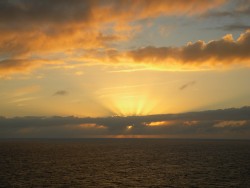There is something stirring to my soul when arriving by sea, whether it be a new land or one I know. Perhaps it’s the slow, steady approach with the anticipation of arrival. I have often arrived by air, viewing the land from above as I try to determine landmarks and flight path. But when you arrive by sea as people have done for hundreds of years, the land slowly comes into view and you must be patient as it takes time to approach and anchor before stepping ashore. The dictionary defines an odyssey as ‘a long journey full of adventures; a series of experiences that give knowledge or understanding to someone’. As we sailed from island to island in the West Indies over the next two weeks, I realized that traveling by ship seemed the perfect way to experience the Caribbean.
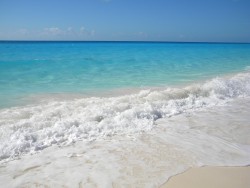
Our first stop was at Half Moon Cay in the Bahamas, also known as Little San Salvador Island. It was my birthday and a sunny, comfortably warm day with beautiful turquoise water and fine white sand beaches. This was my first visit to the Caribbean and we had an active itinerary. Leaving the Bahamas, we would have two days at sea and then arrive at a new island each morning for the next eight days as we cruised in the Lesser Antilles.
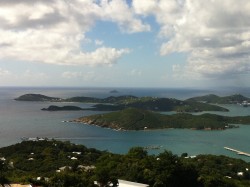
After two days at sea, we docked at Crown Bay Center in Charlotte Amalie on St Thomas in the US Virgin Islands. I walked along the shore into town and then to the Skyride, a tramway up to Paradise Point for lovely views of the harbor and islands. It was a 5.5 kilometer walk (about 3.5 miles) and took over an hour. Returning to the ship, I opted for an open air safari taxi (converted truck beds with covered benches) for only $4.
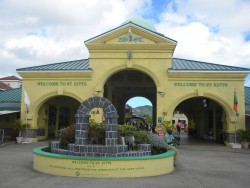
At Basseterre on St Kitts, the port was right in town and I walked along the waterfront out of town headed toward an obelisk in the distance. I was surprised to discover a war memorial with bronze plaques listing twenty men who died during WWI and six men killed during WWII. It had wreaths laid at the base and was an unexpected tribute to find on this island.
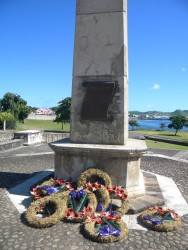
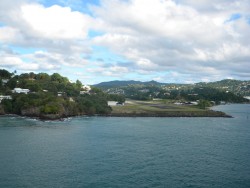
Docked at Carries on St Lucia, I walked into the town center but all was quiet and not much open. I returned to the ship for lunch and sat on deck with a nice view of the island and harbor. In the afternoon, we sailed to Soufrière, a beautiful little town next to the Pitons. The sail around the island was gorgeous and slowly sailing toward the majestic Pitons was enchanting. We anchored briefly to pick up a few passengers from a day long excursion and enjoyed an amazing sunset as we sailed away.
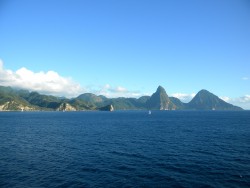
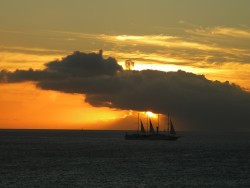
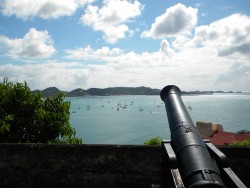
At St George on Grenada, we were docked in town right below Fort George. I walked up a steep hill to the fort and was rewarded with some incredible views of the island, sea and harbor. The fort has been here for over 300 years with old canons still operable and fired off on special occasions. As we sailed away in the late afternoon, a beautiful rainbow bade us farewell.
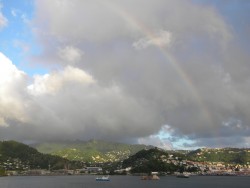
Bridgetown on Barbados was our next port and a highlight of the trip for me. In the 17th century, the British transported enemies of the Crown to this island. The practice was so common that the phrase ‘to be barbadoed’ was often used during that time to indicate punishment. I opted to take an excursion with a tour of this pretty island and the highlight was the ‘Concorde Experience’. British Airways had a daily flight from Heathrow to Bridgetown on a Concorde jet which took just under 4 hours (the current Boeing 777 flight takes 8.5 hours). After the Concorde fleet was retired in 2003, British Airways loaned Concorde G-BOAE to the people of Barbados “in recognition of the role that the island played in Concorde’s success”. It is kept in a specially built hanger and we were able to walk through the jet and hear a bit about the history. We learned that the Concorde flew at Mach 1 and expanded 7 inches during flight due to the heat from the airspeed. After the crash and fire in France, which was not the reason the fleet was retired, the tires were made of Teflar. The expense of fuel and maintenance for the Concorde became too costly for the airlines to continue flying these jets. The interior was one aisle with two leather seats on either side and no separate classes of service. The bathroom had porcelain fixtures and real hand towels. The windows were tiny, not much bigger than the size of your hand and in flight, you could see the curvature of the earth.
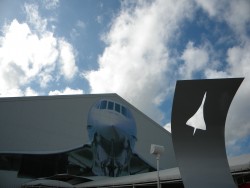
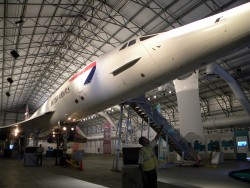
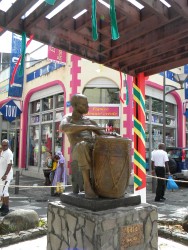
In Pointe-a-Pitre on Guadeloupe, I joined a family from Montreal which helped as they spoke French. We stopped at a market in town and walked around looking for a place to have a glass of champagne. We ended up having a beer in popular spot on the square with wifi. As we sailed away in the early evening a storm was approaching with heavy clouds tinged pinks and blues in the hidden sunset.
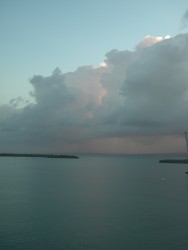
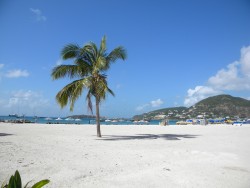
We arrived at Philipsburg on Sint Maartin on New Year’s Day. The stores were open and I walked into town but it was busy with tourists as there were 5 cruise ships in port. I decided to walk along the waterfront and beach as the weather was warm. Butterflies were fluttering everywhere. I continued to see them on the ship deck when we were well out to sea that evening.
Our last stop before heading back to Fort Lauderdale was San Juan, Puerto Rico. I took an excursion to Castillo San Felipe El Morro with a stroll through historic Old San Juan. We were docked in Old San Juan and I walked along the blue cobblestone streets enjoying the architecture, food and history. The cobblestones (blue color is due to age and moisture) were made from furnace slag that was brought to the island as ballast on Spanish ships. The sail away from San Juan Bay around San Felipe El Morro and out to sea was fitting. I thought this must have been the same view of many travelers having arrived or departed by ship or boat at a time when it was the only means of transportation to the island.
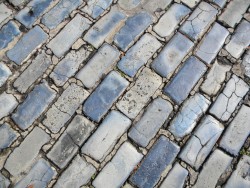
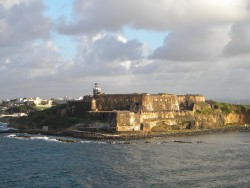
I’m new to cruising, having taken my first one to Norway (Notes from the North Sea) less than a year ago. I have my likes (unpacking once and being well taken care of) and dislikes (crowds and limited time ashore) to traveling on a ship with a thousand plus people. But on this cruise, I enjoyed being in a new port every day with no change of accommodation. It felt very relaxing with no pressure to do anything more than experience each island’s personality and what it had to offer.
